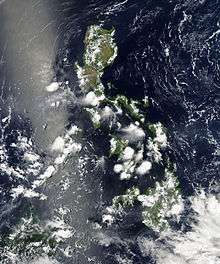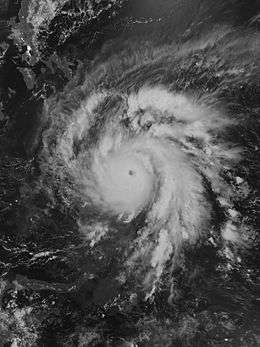Climate of the Philippines

Climate of the Philippines is either tropical rainforest, tropical savanna, tropical monsoon, or humid subtropical (in higher-altitude areas) characterized by relatively high temperature, oppressive humidity and plenty of rainfall. There are two seasons in the country, the wet season and the dry season, based upon the amount of rainfall.[1] This is also dependent on location in the country as some areas experience rain all throughout the year (see Climate types). Based on temperature, the warmest months of the year are March through October; the winter monsoon brings cooler air from November to February. May is the warmest month, and January, the coolest.[2]
Weather in the Philippines is monitored and managed by PAGASA (Philippine Atmospheric, Geophysical and Astronomical Services Administration).
Rainfall
Monsoons are large-scale sea breezes which occur when the temperature on land is significantly warmer or cooler than the temperature of the ocean. Most summer monsoons have a dominant westerly component and a strong tendency to ascend and produce copious amounts of rain (because of the condensation of water vapor in the rising air). The intensity and duration, however, are not uniform from year to year. Winter monsoons, by contrast, have a dominant easterly component and a strong tendency to diverge, subside and cause drought.
The summer monsoon brings heavy rains to most of the archipelago from May to October. Annual average rainfall ranges from as much as 5,000 millimetres (197 in) in the mountainous east coast section of the country, to less than 1,000 millimetres (39 in) in some of the sheltered valleys. Monsoon rains, although hard and drenching, are not normally associated with high winds and waves.
At least 30 percent of the annual rainfall in the northern Philippines can be traced to tropical cyclones, while the southern islands receiving less than 10 percent of their annual rainfall from tropical cyclones. The wettest known tropical cyclone to impact the archipelago was the July 1911 cyclone, when the total precipitation for Baguio was distributed over the four days as: 14th – 879.8 mm (34.6 in), 15th – 733.6 mm (28.9 in), 16th – 424.9 mm (16.7 in), 17th – 200.4 mm (7.9 in);[3][4] followed by extraordinary drought from October 1911 to May 1912, so that the annual amount of those two years were hardly noticeable.
Typhoons

The Philippines sit across the typhoon belt, making dangerous storms from July through October. These are especially hazardous for northern and eastern Luzon and the Bicol and Eastern Visayas regions, but Manila gets devastated periodically as well. Bagyo is the Filipino term to any tropical cyclone in the Philippine Islands.[4] From the statistics gathered by PAGASA from 1948 to 2004, around an average of 28 storms and/or typhoons per year enter the PAR (Philippine Area of Responsibility) – the designated area assigned to PAGASA to monitor during weather disturbances. Those that made landfall or crossed the Philippines, the average was nine per year. In 1993, a record 19 typhoons made landfall in the country making it the most in one year. The fewest per year were 4 during the years 1955, 1958, 1992 and 1997.[5]
PAGASA categorises typhoons into five types according to wind speed. Once a tropical cyclone enters the PAR, regardless of strength, it is given a local name for identification purposes by the media, government, and the general public.[6]
| Type | Maximum sustained wind near its center | |
|---|---|---|
|
|
Tropical Depressions | 30–60 km/h (16–32 kn; 19–37 mph; 8.3–16.7 m/s) |
|
|
Tropical Storms | 61–88 km/h (38–55 mph; 33–48 kn; 17–24 m/s) |
|
|
Severe Tropical Storms | 89–117 km/h (55–73 mph; 48–63 kn; 25–33 m/s) |
|
|
Typhoons | 118–219 km/h (73–136 mph; 64–118 kn; 33–61 m/s)[7] |
|
|
Super Typhoons | more than 220 km/h (140 mph; 120 kn; 61 m/s) |
Public Storm Warning System (PSWS)
For the past ten years, the Philippines has experienced a number of extremely damaging tropical cyclones, particularly typhoons with more than 220 km/h (140 mph; 120 kn; 61 m/s) of sustained winds. Because of this, the Super Typhoon (STY) category with more than 220 km/h (140 mph; 120 kn; 61 m/s) maximum sustained winds was officially adopted by the PAGASA. However, according to different stakeholders, the extensive and devastating damages caused by strong typhoons such as Typhoon Yolanda in 2013 made the four‑level warning system inadequate. With this development and to give emphasis in warning for Super Typhoon, the warning system is modified as follows:
|
|
Signal No. 1 | winds of 30–60 km/h (16–32 kn; 19–37 mph; 8.3–16.7 m/s) and expected in 36 hours on first issuance. |
|
|
Signal No. 2 | winds of 60–120 km/h (37–75 mph; 32–65 kn; 17–33 m/s) and expected in 24 hours on first issuance. |
|
|
Signal No. 3 | winds of 120–170 km/h (75–106 mph; 65–92 kn; 33–47 m/s) and expected in 18 hours on first issuance. |
|
|
Signal No. 4 | winds of 170–220 km/h (110–140 mph; 92–119 kn; 47–61 m/s) and expected in 12 hours on first issuance. |
|
|
Signal No. 5 | winds more than 220 km/h (140 mph; 120 kn; 61 m/s) and expected in 12 hours on first issuance. |
Strongest Typhoons
Typhoon Haiyan
The deadliest typhoon to impact the Philippines was Typhoon Haiyan, locally known as Yolanda, in November 2013, in which more than 6,300 lives were lost from its storm surges and powerful winds. Over 1,000 went missing and nearly 20,000 were injured. Winds reached 315 km/h (196 mph; 170 kn; 88 m/s) in one–minute sustained and may have been the strongest storm in history in terms of wind speeds as wind speeds before the 1970s were too high to record.
Typhoon Angela
Back in 1995, where Typhoon Angela, known as Rosing was an extremely catastrophic category 5 typhoon that made landfall in Catanduanes and made across Manila. Winds reached 290 km/h (180 mph) on one-minute sustain winds. Rosing took 936 lives and the most powerful typhoon that ever hit Metro Manila.
Typhoon Bopha
On late December 3, 2012, Typhoon Bopha or known as Pablo made landfall on Eastern Mindanao, damage was over 1.04 billion USD by winds of 280 km/h (175 mph) on one-minute sustain winds. Typhoon Bopha was the most powerful typhoon ever hit Mindanao, killing 1,067 people and 834 people were missing. Most of the damage was caused by rushing storm surges and screaming winds.
Typhoon Megi
In terms of central pressure, Typhoon Megi (2010) measured 885 mb. This was the strongest storm ever to make landfall in terms of pressure.
When it comes on the winds, are nearly 300 km/h (190 mph) on one-minute sustain and killing 67 people and damage was over 700 million USD
Climate types
 Philippine Climate Map |
| Four kinds of tropical sunshine (°C) |
|---|
 |
| Four kinds of tropical rain (mm) |
| 100
200
300
400
500
600
700
J
F
M
A
M
J
J
A
S
O
N
D
|
There are four recognized climate types in the Philippines, and they are based on the distribution of rainfall (See the Philippine Climate Map).[lower-alpha 1] They are described as follows:[1]
|
|
Type Ⅰ | Two pronounced seasons: dry from November to April and wet during the rest of the year. |
|
|
Type Ⅱ | No dry season with a pronounced rainfall from November to January. |
|
|
Type Ⅲ | Seasons are not very pronounced, relatively dry from November to April, and wet during the rest of the year. |
|
|
Type Ⅳ | Rainfall is more or less evenly distributed throughout the year. |
| ||||||||||||||||||||||||||||||||||||||||||||||||||||||||||||||||||||||||||||||||||||||||||||||||||||||||||||||||||||||||
| ||||||||||||||||||||||||||||||||||||||||||||||||||||||||||||||||||||||||||||||||||||||||||||||||||||||||||||||||||||||||
| ||||||||||||||||||||||||||||||||||||||||||||||||||||||||||||||||||||||||||||||||||||||||||||||||||||||||||||||||||||||||
| ||||||||||||||||||||||||||||||||||||||||||||||||||||||||||||||||||||||||||||||||||||||||||||||||||||||||||||||||||||||||
Temperature
The average year-round temperature measured from all the weather stations in the Philippines, except Baguio City, is 26.6 °C (79.9 °F). Cooler days are usually felt in the month of January with temperature averaging at 25.5 °C (77.9 °F) and the warmest days, in the month of May with a mean of 28.3 °C (82.9 °F).[1] Elevation factors significantly in the variation of temperature in the Philippines. In Baguio City, with an elevation of 1,500 m (4,900 ft) above sea level, the mean average is 18.3 °C (64.9 °F) or cooler by about 4.3 °C (8 °F). In 1915, a one-year study was conducted by William H. Brown of the Philippine Journal of Science on top of Mount Banahaw at 2,100 m (6,900 ft) elevation. The mean temperature measured was 18.6 °C (65.5 °F), a difference of 10 °C (18 °F) from the lowland mean temperature.[12]
Humidity
Relative humidity is high in the Philippines. A high amount of moisture or vapor in the air makes hot temperatures feel hotter. This quantity of moisture is due to different factors – the extraordinary evaporation from the seas that surrounds the country on all sides, to the different prevailing winds in the different seasons of the year, and finally, to the abundant rains so common in a tropical country. The first may be considered as general causes of the great humidity, which is generally observed in all the islands throughout the year. The last two may influence the different degree of humidity for the different months of the year and for the different regions of the archipelago.[13]
Seasons
The climate of the country is divided into two main seasons:
- the rainy season, from June to November;
- the dry season, from December to May. The dry season may be subdivided further into (a) the cool dry season, from December to February; and (b) the hot dry season, from March to May.[1] The months of April and May, the hot and dry months when schools are on their long break between academic years, is referred to as summer while in most of the northern hemisphere those months are part of spring.
| Months | December–February | March–May | June–August | September–November |
|---|---|---|---|---|
| Rainfall | ||||
| Temperature | ||||
| Season | ||||
See also
Notes
- ↑ This classification was first established by Coronas 1920, pp. 68–72 and then slightly modified by PAGASA (Flores & Balagot 1969; Kintanar 1984).
References
- 1 2 3 4 "Climate of the Philippines". Philippine Atmospheric, Geophysical and Astronomical Services Administration. Retrieved 26 November 2015.
- ↑ Coronas 1920.
- ↑ Coronas 1920, p. 110.
- 1 2 Glossary of Meteorology. Baguio. Retrieved on 2008-06-11.
- ↑ Philippine Atmospheric, Geophysical and Astronomical Services Administration. "Tropical Cyclone Statistics". Retrieved on 2010-06-26.
- ↑ Atlantic Oceanographic and Meteorological Laboratory, Hurricane Research Division. "Frequently Asked Questions: What are the upcoming tropical cyclone names?". NOAA. Retrieved 2006-12-11.
- ↑ "Hurricanes... Unleashing Nature's Fury: A Preparedness Guide" (PDF). NOAA. September 2006. Retrieved 2006-12-02.
- ↑ "Climatological Information for Manila". AmbiWeb GmbH. Retrieved 17 February 2016.
- ↑ "Climatological Information for Borongan, Eastern Samar". AmbiWeb GmbH. Retrieved 17 February 2016.
- ↑ "Climatological Information for Cebu City". AmbiWeb GmbH. Retrieved 17 February 2016.
- ↑ "Climatological Information for General Santos". AmbiWeb GmbH. Retrieved 17 February 2016.
- ↑ Coronas 1920, p. 53.
- ↑ Coronas 1920, p. 125.
Sources
- Coronas, José (1920). The Climate and Weather of the Philippines, 1903 – 1918. Manila Observatory: Bureau of Philippines.
- Flores, J. F.; Balagot, V. F. (1969). Arakawa, Hidetoshi, ed. Ch. 3: Climate of the Philippines. World Survey of Climatology. Vol. 8: Climates of Northern and Eastern Asia. Elsevier. ISBN 978-0444407047.
- Kintanar, R. L. (1984). Climate of the Philippines. PAGASA.
